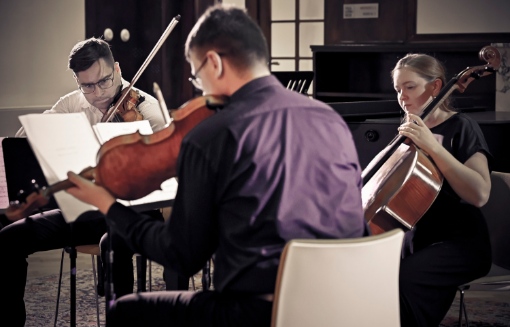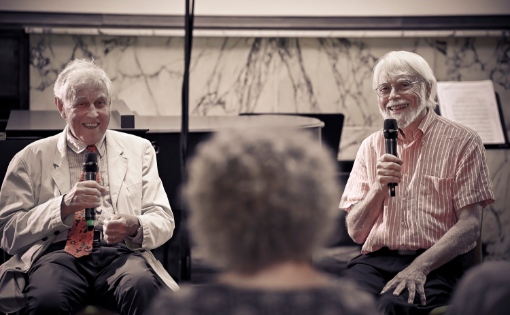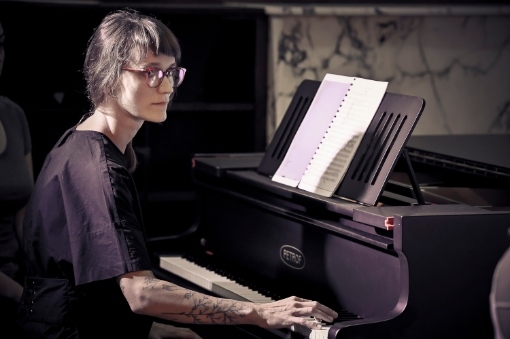The Ensemble Opera Diversa has already presented several compositions by David Matthews (*1943) to Brno audiences, and in most cases these were Czech or even world premieres. This year Matthews’ 80th birthday was celebrated with a performance by the above-mentioned ensemble, or rather its chamber branch Diversa Quartet, headed by dramaturge Jiří Čevela, with a concert on 20 September at the Villa Löw-Beer. The programme, consisting of works by composers closely associated with David Matthews himself, including his own compositions, was preceded by an hour-long discussion in the presence of the composer. Matthews is a British-born composer with long-standing ties to the Brno circle of composers and musicologists. In addition to his participation in the so-called "apartment seminars" in the 1980s, he also is friends with several personalities such as composer, pedagogue and oboist Pavel Zemek Novák (*1957).
The evening opened with an early work by Gustav Mahler (1860-1911), Piano Quartet in A minor. The unfinished opus represents one of the few chamber instrumental works by the composer that have survived. Mahler wrote the quartet at the age of sixteen, i.e. at a very young age, and in it we can sense the influence of the likes of Mendelssohn and Schumann. Although it is an early composition, many elements - expressiveness, tendency to catharsis, sudden contrasts - anticipate his ultimate musical style. The piece was included in the programme in view of David Matthews' compositional connection with Mahler's late romantic musical language. In addition, the two composers are also linked by the fact that Matthews participated in the reworking of Mahler's unfinished Symphony No. 10, which was published in its completed version in 1976. The Piano Quartet in A minor, performed by the Diversa Quartet and pianist Kristýna Znamenáčková , stood out for its colourfulness, the clear overlapping of motifs between the instruments and the endless tension towards the aforementioned catharsis. Purity of musical expression and precise, clear articulation dominated in the piano part, especially in the figurations and chordal decompositions.

The piece Double for David Matthews by Brno composer Peter Graham (*1952) for flute and clarinet, with its gentle, playful and changing character, worked as an instrumental and sonic contrast to the previous work. Although Peter Graham composed it in 1990, in the case of the concert in question, the audience had the opportunity to enjoy the work in a superb performance by Eva Bergerová (flute) and Jiří Tolar (clarinet). The duet dedicated to the new octogenarian is also based on musical material from his mixed choir. “The pitches in the opening movement are taken from the inner voices of a mixed choir by David Matthews. In the following course, both these tones and the intervals between them are worked with." writes Peter Graham in his author's commentary. The single-movement work is clearly divided into several contrasting areas (labelled A, B, C etc. by the composer), during which the serious, poetic character alternates with lighter sections full of "banter", rhythmic and dance elements.
Pavel Zemek Novák met the British author during his stay in the UK. It was there in Gloucestershire in 2000 that Novák's Variations on a Painswick Cathedral Hymn (sometimes also referred to as Marian Variations) for piano quartet had its world premiere. The meditative piece was composed between 1999-2000 on the initiative of the Painswick Music Society, to which it is dedicated. The plan is based on the three-nave architecture of Painswick Cathedral and the link is the three Ritornels, which graphically hide the letter "M" as in Maria. The author talks about the movement plan of the form as follows: “...in the classical (classical-romantic) tradition, this movement concept is applied in slow movements - it is a constantly accelerating movement towards the end. In Variations, this concept of movement is applied throughout the cycle. The rapid movement of the variation parts reminds us of the changing life around the cathedral (the changing seasons), the unchanging ritornello reminds us of its immutability." The abundant use of low dynamics (pp, ppp) and imaginative instrumentation also refer to silent Marian prayer. The combination of musical material, techniques and instruments used here enhance the delicacy and fragility of the musical moment. The movements with the piano in a high position, which were complemented by pizzicato in the strings, were particularly imaginative. Then there are passages with a mute or with precisely written trills, and last but not least, isolated multi-layered timbral areas, sometimes approaching stratophony. Many of the motifs and figurations in the piano part were reminiscent of birdsong in their melodic-rhythmic character (especially in the opening movement Left Ship - Spring). In the last part, entitled Chapel of St. Peter (Winter) cellist Iva Wiesnerová introduced her substantial, exposed and tactilely demanding solo to the audience. As a whole, the composition gives the impression of capturing a mood or that transformation mentioned by Pavel Zemek Novák in his commentary, which the performers have convincingly translated into sound form.

David Matthews worked for Benjamin Britten (1913-1976) as Britten's permanent musical assistant at the Aldeburgh Festival. He helped Britten with arrangements of his works, which he subsequently conducted at this festival. He prepared revisions and new critical editions of Britten's compositions for the Faber Music publishing house, and his monograph on Britten can be considered the metaphorical peak of his friendship and collaboration with Britten. It is therefore not surprising that Britten's early composition Rhapsody for string quartet was included in the concert programme. This piece is not one of the most frequently performed works of the British classical composer, and therefore we cannot say for sure whether this is also a Czech premiere. Similarly to Mahler, Benjamin Britten wrote his string quartet at a young age (fifteen) in early 1929. The sonic density and dense texture refer more to the late Romantic style, often similar in construction and urgency to the opening Mahler piece. The one-movement work contains veiled harmonies and plenty of space for viola and violin solos. The Diversa Quartet's performance was precise, heartfelt and again very expressive.
The last piece performed at the concert was the Piano Quintet, Op. 92 from 2004 by the oft-mentioned birthday boy David Matthews. The four-movement work was also the second Czech premiere in the programme (the work was premiered in Cardiff in 2004). The main pillars on which the author relies compositionally are diatonicism, polyphony and dance surfaces, in this case well known in the second movement of Tango. Urgente. The extreme lyrical sections are also accompanied by a dialogic quality, a lighter colour, which is thickened in the piano by staccato chords, or a more varied movement and a brisk tempo in general. The slow, third movement is composed on the principle of ciaccona, where the ostinato theme travels across the instruments. The theme also moves up one third each time, so that on the third repetition it returns to its original position. The static quality that emanates from the ostinato principle of this form did not, thanks to the imaginative instrumentation, sound monotonous. The highlight of the whole work is the fourth and last movement, which grows out of the motif, provided by bells that the composer heard ringing from a monastery during his holiday in Italy. The bells inspired him to create musical material, which he uses throughout the last movement. It flows, in the composer's words, into an "unbridled and exuberant" coda.
Programme:
Gustav Mahler: Piano Quartet in A minor
Peter Graham: Double for David Matthews for flute and clarinet
Pavel Zemek Novák: Variations on the Painswick Temple Hymn
Benjamin Britten: Rhapsody for string quartet
David Matthews: Piano Quintet, Op. 92
Cast:
Diversa Quartet
Barbara Tolarová - 1st violin
Jan Bělohlávek - 2nd violin
David Křivský - viola
Iva Wiesnerová – cello
Kristýna Znamenáčková - piano
Eva Bergerová - flute
Jiří Tolar - clarinet
































No comment added yet..